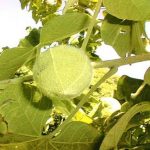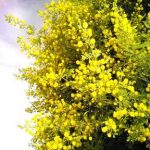TREE LIFE
August 2015
MASHONALAND CALENDAR
1st August : Botanic Gardens Walk. Meet at the main car park at 0845 for a 0900 hours start. This walk will last about 1.5 hours. There may be the first signs of spring and certainly the weather will be a bit warmer. Come and enjoy these beautiful gardens.
16th August : Outing to Hildemara Park in the Trelawney District by kind invitation of the Passaportis family. Hildemara is one of the hidden treasures waiting to be explored, botanized and enjoyed. It is a one and a half hours drive from town and there is MUCH to be seen so I suggest an early start – ie meet at Prince Edward School car park for an 0745 hours get away. Bring the usual – picnic lunch and teas, chairs, hats and water. The committee strongly recommends that we travel together to avoid the situation of directions being misread etc.
August 22nd. Outing to Rolf and Maia Chenaux Reponds lovely garden in Sentosa. We have visited here before but one does not tire of exploring the treasures hidden in gardens – we might even find something new!
Things to look forward to and diarise now:
September 20th : Outing to Calderwood Park near Peterhouse School. Do not think I am meaning Gosho Park!!! Calderwood Park is on the other side of the road from Gosho Park and Meg and Penny Raynor (i/c conservation at Peterhouse School) assure us of an exciting day. Remember, also, Brachystegias will be out in all their glory.
November 6th – November 10th : Botanising expedition to New Year’s Gift Estate in the Chipinge District, and we also hope to spend one of the days exploring the Chirinda Forest. We will be accommodated at the New Year’s Gift training school. There is accommodation for 20 people so it will be on a first come first get basis. The accommodation is in rondavels each with two beds and own ablutions and there is a community dining/socialising area all set in lovely gardens. The cost will be $30 per person per night and $7 a meal. I suggest we all partake of the main evening meal together and then, depending on how we feel, individually plan for the other two meals, certainly lunches will be picnic affairs wherever we are on that day. There is fridge and deep freeze space available at the main dining area but no cooking facility in the rondavels. There will be more detailed details to follow – this is just to give you something to think about. Mark and Meg will be leading us.
TREE OF THE MONTH Faurea rochetiana (prev: Faurea speciosa)
Family: – PROTEACEAE
Common names: Broad-leaved Beechwood; Nd: Umdwadwa; Sh: Mutsatsati.
Etymology: The name ‘Proteaceae’ by Antoine Laurent de Jussieu in 1789 was based on the genus ‘Protea’, which in 1767 Carl Linnaeus derived from the name of the Greek god Proteus, a deity that was able to change between many forms. This is an appropriate image, seeing as the family is known for its astonishing variety and diversity of flowers and leaves. Genus name: William Henry Harvey named the genus after William Caldwell Faure (1822-1844), a young soldier and enthusiastic botanist who was killed in active service in India .
The specific epithet commemorates C.L.X. Rochet d’Herincourt, a French chemist who took part in an exploring expedition to Ethiopia between 1839 and 1845, and who collected the first recorded specimen of this species there.
In Zimbabwe the Proteaceae include three well known proteas, i.e. Protea angolensis, Protea gaguedi and Protea welwitschii as well as two Faurea, i.e. Faurea saligna and Faurea rochetiana.
Faurea rochetiana is mostly found in the Eastern Highlands, even though they are also scattered in other areas. It really is a spectacular sight when in flower when not in flower it can easily be overlooked as some Combretum but a closer look will dispel any confusion.
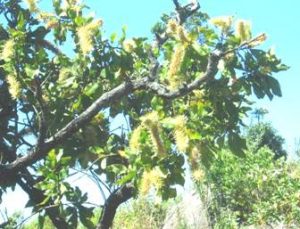
Faurea rochetiana flowers
The crooked, contorted trunks are an important character that distinguishes
F. rochetiana from its relatives. It is a small tree, 4-7 m high the bark is craggy, rough and fissure and almost black on old trees mature trunks.
The leaves, very hairy when young, lose their hair with maturity; unusually in this family.
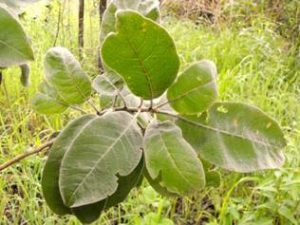
Faurea rochetiana leaves
Leaves are short-stalked and usually 70-170 x 25-60 mm, wider than most other Proteaceae; the upper surface is noticeably darker green than the lower; these two characteristics are important as they clearly separate F. rochetiana from other species. The leaves turn attractive shades of crimson in autumn.
The flowers hang in very conspicuous spikes, up to 250 mm long, starting in late summer and continuing to the following spring (February-March to September). The individual flowers are creamy yellow. The fruit is a small nutlet ripening about three months after flowering.
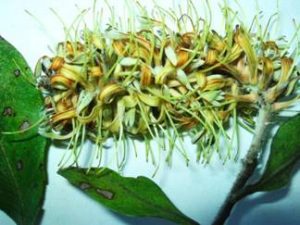
Faurea rochetiana flower spike
The wood is of little commercial value as it is difficult to find straight pieces of usable diameter. It is nevertheless used for small articles of furniture, fence posts and carving where the grain of the wood can be better appreciated.
On the medicinal uses I believe that, just like F. saligna, an infusion of roots can be taken against diarrhoea.
Sources:
Coates Palgrave, K. 1977. Trees of Southern Africa . Struik, Cape Town.
Gelfand, M. et.al. 1985. The Traditional Medical Practitioner in ZImbabwe. Mambo Press, Gweru.
Goldsmith, B. and Carter, D.T. 1992. The Indigenous Timbers of Zimbabwe. Forestry Commission, Harare.
PlantzAfrica – Website of the South African Botanical Institute. www.plantzafrica.com
Van Wyk, B. and Van Wyk, P. 1997. Field Guide to the Trees of Southern Africa . Struik, Cape Town.
-J.P. Felu
TREE SOCIETY VISIT TO CATAPU, SOFALA PROVINCE, MOZAMBIQUE 25th APRIL – 2ND MAY 2015
CONTINUED
Thursday 30th April – The reforestation programme.
The last Tree Society outing to Catapú was three years ago, so it was interesting to see the progress in Ant White’s pioneering work to re-establish fire damaged and degraded forest. The areas rehabilitated include fire damaged areas invaded by Acacia adenocalyx and a borrow pit from the days when the main road was being made, from which the top soil has been removed down to underlying clay, and which to my surprise gives the faster growth. Fire damage occurs in patches, so unburnt areas were left in their natural state and Ant had cleared the invasive plants and dead trees from the fire damaged areas.
The first regeneration trial started in the 1988/99 season, by replanting burnt areas with seedlings and allowing coppicing where possible. Coppicing with subsequent reduction to one stem is most successful in Millettia stuhlmannii (Panga Panga) with 100% success rate, but Afzelia quanzensis (Pod Mahogany) and Cordyla africana (Wild Mango) only have 4% success rate. Propagation can also be from seedlings or rooted truncheons which have been taken and planted in the nursery in September when the sap is rising.
We were shown two regeneration areas. The first was planted in 1998/99 as a combination of coppices, seedlings and rooted truncheons with a mixture of commercial species (Panga Panga, Pod Mahogany and Wild Mango). Each tree is numbered and planted at a spacing of 7m, or 1600 trees per hectare. Panga Panga in particular is reduced to one coppice stem and pruned, if it branches early, to produce a straight bole. The Mean Annual Increment (MAI) is recorded annually, which is the annual volume increment. Ant told us something I did not know: researchers from the University of Southern Illinois had taken wedge samples from the known-aged trees in this plot and shown that there can be two annual growth rings if the there is enough rainfall in the year. This research showed that a Panga Panga tree of 400mm DBH is 60 – 66 years old, so this is the age of these trees when they are harvested at Catapú.
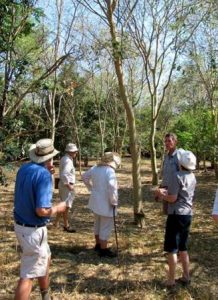
Members at Catapu
The newest re-establishment site is on an area called Mashamba John Fletcher, a very fitting tribute and monument to Ant’s great friend. What appeals to me is that anyone can buy a tree for a very nominal amount and it will be planted by Ant, but under Mozambique law it belongs to the buyer. Records of the name of the owner, its number and the GPS position are kept for each tree planted. I shall look forward to a visit in future one November when the main road is lined with flowering Fernandoa magnifica with its striking bright orange or crimson flowers, when there are millions of butterflies and you can see the elusive Angola Pitta. What a fitting setting and memorial when we are no longer around!
– John Meikle
Friday, May 1st – The Limestone area
Today, we visited an area of calcite, some distance from M’Phingwe, hoping that some different and interesting tree and plant species would be found. The area itself turned out to be mainly grassland with occasional isolated trees. As we were no longer in the dry forest, the species were different and indeed were mainly familiar species from low altitudes in Zimbabwe.
For example, there were three well-known species of Combretum, namely Combretum apiculatum, C. hereroense and C. erythrophyllum. Also present was the False Marula, Lannea schweinfurthii. Another familiar species was Piliostigma thonningii, Monkey bread.
A more interesting find was Croton menyharthii, which can be recognised by its rough upper leaf surface. This turned out to be new to Meg’s list of trees for Catapu. Other well-known species seen were Flueggea virosa (Snowberry), Dombeya rotundifolia and Annona senegalensis.
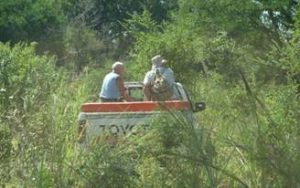
Travelling around at Catapu
Nearby were a couple of dried-up boggy areas and one or two interesting herbaceous plants were found; these are still to be named. There was also a pinkish-flowered Ipomoea which was new to me. Overall though, nothing very interesting was found [ !! – no interesting additions for the Flora of Mozambique – Ed], apart from the Croton menyharthii.
Catapu Botanical Meander
To have the top three plant authorities of the region taking us through the mosaic of woodland and forest on Catapu was a privilege¬ – the doyenne Meg C –P, Mark Hyde and Tom Muller in his signature singlet and hatless (who I have known since he was at the Herbarium and I was at Salisbury Research station, 52 years ago). Meanwhile we amateurs were trotting behind trying to make head or tail of it all! So it can be amusing when the fundis are differing over a Strychnos and Tom Muller pulls out his penknife to slash the bark and confirms the diagnosis with a disappointed frown from Meg!
As a struggling amateur, I do find keys confusing when a slight difference leads you to make a wrong decision and lands you up a gum tree! What I am trying to learn are the similar features of each family, because keys emphasise simple and compound leaves as distinguishing features, but confusingly within some families’ leaves can be simple or compound. Here’s my amateur effort to make sense of the major families we saw on one morning outing, concentrating on species that are typical of this area and uncommon in Zimbabwe.
Papilionaceae (Pea and Bean family)
Common features are pea-shaped flowers which are crimson, purple, yellow or white, pods varying from fleshy (wild mango) to large and winged (mukwa), leaves alternate.
Of the Millettias, the commercial M. stuhlmannii is distinctive with its greeny bark, but the other lesser known seen were M. usaramensis (smaller Millettia) and M. mossambicensis (Sankala) a slender tree with velvety under leaf is endemic to this area. The Wing-pod Xeroderris stuhlmannii can be a large tree with pinnate leaves and large pods. Of the Dalbergias we saw D. boehmii (large-leaved Dalbergia) whose bark has fine longitudinal fissures and D. melanoxylon (Zebra wood) often multi stemmed, which has rough peeling bark and whose leaves often have galls.
Euphorbiaceae
Common characteristics are simple, alternate leaves, milky or watery latex, a pair of glands where the petiole joins the leaf blade, stipules and stipular scars, three lobed fruit. Drypetes reticulata (False forest iron plum) has a fluted trunk, coppicing at the base. Cleistanthus schlechteri (Umzithii) alternate leaves with domatia. Alchornea laxiflora (Lowveld Bead string) where leaves are reddish when young, developing in autumn colours of plum to yellow.
Rhamnaceae
This family has no easily identifiable common characteristics. Berchemia discolor (Bird plum) has dark fissured bark, large leaves, shiny green above, paler green below.
Malvaceae (Hibiscus family)
Leaves are simple with at least 3 distinct veins from the base with two swellings on the petiole, leaves alternate and stipulate. Grewia inaequilatera (Large leaved yellow Grewia). This is a small shrub forming thickets.
Loganiaceae (Monkey orange family)
Leaves are simple, opposite or whorled. Stipules can be reduced. At least 3-veined from the base with entire leaf margins. Strychnos henningsii (Red bitter berry). A small shrubby tree or a large tree. The fundis had to resort to the penknife to identify this from the orange slash! S. madagascariensis (Black monkey orange) Does grow into a large tree at Catapu.
S. usambarensis (Blue bitter berry). Three veined from the base, multi stemmed.
Rubiaceae (Coffee family)
Leaves opposite (occasionally whorled), margins entire. Pockets often in axils of veins on the leaf under surface. Oxyanthus latifolius (Sand forest – loquat) is a small tree or shrub, usually multi stemmed. Heinsia crinita (Jasmine – gardenia) is a small tree or shrub with white flowers 3 – 4 cms in diameter and a corolla tube up to 3cms long and orange fruit.
– John Meikle
Saturday, May 2nd and Sunday, May 3rd – Departure
On Saturday morning we all settled up and set off along the dreadful road to Inchope. We took 2 hours to do 100 kms, but as we went South things improved and we stopped by the bridge over the Pungwe for a picnic lunch. We had two expensive and unpleasant incidents with officials on the way. The three of us (Meg, Tom and myself) spent the night at Chimoio with friends. On Sunday, we had a misty start in Chimoio. It was an uneventful run to the border, a straightforward crossing and then the final leg to Harare.
Conclusion
Firstly, a big thank-you to Meg for arranging the trip and organising the outings each day we were there. I am sorry to report that Meg was the only person on the trip who caught malaria.
Thanks also to Ant, our genial host, for giving us so much of his time and for sorting out the problems that arose, whether they consisted of boomslangs in bedrooms or damaged vehicles. Thanks also to the staff at M’Phingwe for providing excellent service.
Overall, the vegetation was a bit disappointing. On the previous trip, which was a bit earlier in April, the herbaceous vegetation had been in excellent condition, fresh and green, with many sedges and grasses. On this trip, rain had obviously ceased some weeks before and the ground cover was mostly dried out. The rainy season had actually been a good one and the pans had filled up for the first time for some years. Ironically, therefore, we did quite well with water plants, although these are at this stage still to be named.
For the record, 13 people went on the trip and they were as follows:
Jim and Ann Sinclair, John and Barbara Meikle, Bilal Khatri, Don and Carrie Lapham, Graham Mills, Mary Lovemore, Isla Grundy , Mark Hyde, Tom Muller and Meg Coates Palgrave.
– Mark Hyde
OUTING TO CHEDGELOW FARM SUNDAY 21ST JUNE, 2015
Tony, Meg, Dean and I met at the Mukuvisi car park at 8.30am for departure to Chedgelow. We four set off, finding the Felus along the way. The route markers clarified our route thereafter. Mary, Graham and Bilal were already there plus gardener to assist us all. Craig Dankwertz had kindly placed two security guards at the site.
Craig’s Grandfather bought the farm in 1945, and with his son John and now grandson Craig, it has remained in the family. We passed the deep gravel quarry on our way in, which Craig’s grandson is now foreman. The proximity of Epworth provides the labourers needed. The farm has rock paintings and so many beautiful spots for picnics or special events, and the outstanding woodland has remained.
As Meg had her newly printed Highveld and Middleveld key with her, copies were bought and duly signed.
So now to our tree walk, armed with notebooks, glasses, hats and warmly dressed for the overcast chilly morning! Our first leaf picked was Azanza garckeana, the Snot Apple, right next to an enormous boulder across the sandy road. The leaf was a bit unusual as it was more rounded, instead of being lobed. Mary listed trees and Meg confirmed their GPS reading, while the rest of us were encouraged to identify not by remote observation, but by true scrambling here and there for specimens!
Discussions ensued on Strychnos fruit, the round pod of the Mukwa and how best to obtain its seed in the midst of all its prickles for germination, the ability of Ochna pulchra to continue photosynthesising through its smooth green bark when all the leaves have fallen. We were encouraged to find the obvious (to Meg mainly) ‘labels’ of the trees, most of us still finding our memories and observations somewhat lacking.
Galls on the Brachystegia, blackened and large, as well as small ones on low lying shrubby trees, reminded us that although the gall is started by insect hormones to provide a safe growing environment for their progeny, they do not use an antidote to end the process!
What have we here? Meg called, as we reached a large antheap: Pappea capensis – the Indaba tree – and Grewia …Yes, said Tony, observing the fruit up high, some green, some red. “What kind of leaf is this?” asked Meg, as we looked at one with a main stem and many lobes from a creeper. Reply: Good Christmas quiz question! Hanging seeds like a bra, or false teeth here?” Easier names possible than Aeschynomene!
So the time passed as Meg led us on toward the Henry Hallam Dam, all so very pretty and peaceful, where we sat quietly observing water birds and enjoying our surroundings. We so enjoyed the Aloes and the Kalanchoe with their vivid colouring set amongst the rocky outcrops.
Walking back, we set up our picnics, sharing the enjoyment of our very happy day out, in every aspect. Being 21st June the shortest day and chilly, it was decided we forego the afternoon walk.
– Sarah Roberts
Chedgelow Farm – Tree Society Outing on 21 June, 2015. List of trees recorded – GPS reading at car park site 1757.831 3107.295 . Altitude 1445m
Azanza garckeana; Cassia abbreviata; Elephantorrhiza goetzei; Ziziphus mucronata; Euclea natalensis; Combretum molle; Aloe chabaudii; Afrocanthium lactescens; Vitex payos; Ochna puberula; Strychnos cocculoides; Sansevieria cylindrica; Swartzia madagascariensis; Pterocarpus angolensis; Monotes glaber; Pittosporum viridiflorum; Albizia antunesiana; Leptactina benguelensis; Lopholaena coriifolia (a natural invader); Catunaregam taylorii; Ochna pulchra; Pavetta schumanniana; Lippia javanica; Vangueria infausta; Kalanchoe lanceolata; Gardenia volkensii; Flacourtia indica ; Searsia tenuinervis; Ficus burkei; Psydrax livida; Burkea africana; Peltophorum africanum; Ozoroa reticulata; Steganotaenia araliacea; Strychnos spinosa; Parinari curatellifolia; Pappea capensis; Pouzolzia mixta; Grewia monticola; Pterocarpus rotundifolius; Combretum collinum; Sericanthe andongensis; Dombeya rotundifolia; Vangueriopsis lanciflora; Tricalysia niamniamensis; Searsia longipes; Gymnosporia senegalensis; Searsia leptodictya; Garcinia huillensis; Aeschynomene sp.; Cussonia arborea; Grewia decemovulata; Combretum zeyheri; Ximenia caffra; Vernonia glabra; Lannea discolor; Faurea saligna; Dichrostachys cinerea; Ficus natalensis; Senna singueana; Euclea crispa; Julbernardia globiflora; Brachystegia spiciformis; Brachystegia glaucescens.
Mary
Botanical Garden Walk on afternoon of 27th June
We had an excellent turn out of 14 members, including two interested and interesting new folk who joined us, on a brilliantly crisp winter afternoon. The objective of the walk was to explore the wild area around the kopjie behind the herbarium. This is not a much walked in section of the garden and we decided it would be exciting to investigate this area as a group. We were ably led by Ann Sinclair, who, together with her husband Jim, regularly walk in this section of the garden and who had really “sassed out” the walk to be done.
It turned out to be a time of really stimulating discussions as the fundis Mark, Ann, Dave, Tony, other Ann, Bilal et. al. discussed, debated and then were defeated on many of the species, particularly when it came to the figs and in the Combretum section. We were also defeated at the final tree we looked at, a really magnificent Pterocarpus in glorious autumn attire made even more spectacular as it stood silhouetted against the setting sun.
We had a good walk, a good time of camaraderie and the general consensus was that we must do the walk again when Tom (who was responsible for planting all these “foreign” trees) comes back from his annual holiday. Roll on October and another outing to this beautiful bit of woodland with our guru Tom!!
-Mary Lovemore
TONY ALEGRIA CHAIRMAN


